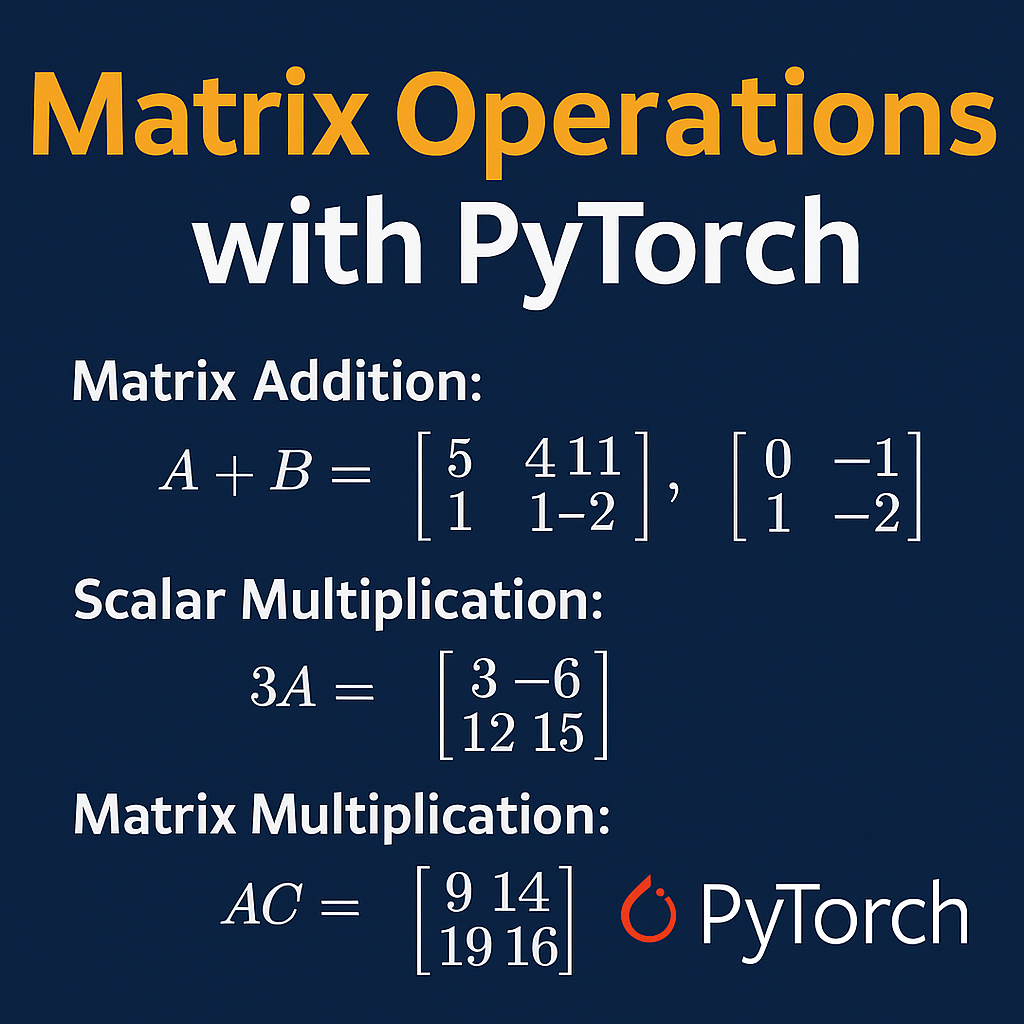Matrix Operations with PyTorch
Author: Bindeshwar Singh Kushwaha
Institute: PostNetwork Academy
Matrix Addition and Scalar Multiplication
- Matrix Addition: We add corresponding elements of the same-sized matrices:
\( A + B = [a_{ij} + b_{ij}] \) - Scalar Multiplication: Multiply each element of the matrix by the scalar value:
\( kA = [k \cdot a_{ij}] \) - Example:
\( A = \begin{bmatrix} 1 & -2 & 3 \\ 0 & 4 & 5 \end{bmatrix}, \quad
B = \begin{bmatrix} 4 & 6 & 8 \\ 1 & -3 & -7 \end{bmatrix} \) - Results:
\( A + B = \begin{bmatrix} 5 & 4 & 11 \\ 1 & 1 & -2 \end{bmatrix}, \quad
3A = \begin{bmatrix} 3 & -6 & 9 \\ 0 & 12 & 15 \end{bmatrix} \) - Note: Matrix addition is only defined when both matrices have the same dimensions.
Matrix Multiplication
- Matrix Multiplication: Multiply row of A with column of B:
\( (AB)_{ij} = \sum_{k=1}^{p} a_{ik} b_{kj} \) - This operation is only valid if the number of columns in A equals the number of rows in B.
- Example:
\( A = \begin{bmatrix} 1 & -2 & 3 \\ 0 & 4 & 5 \end{bmatrix}, \quad
C = \begin{bmatrix} 2 & 0 \\ 1 & -1 \\ 3 & 4 \end{bmatrix} \) - Result:
\( AC = \begin{bmatrix} 9 & 14 \\ 19 & 16 \end{bmatrix} \) - Note: Matrix multiplication is not commutative, i.e., \( AB \neq BA \).
PyTorch Implementation
This Python code performs the matrix operations above using PyTorch tensors:
import torch
A = torch.tensor([[1, -2, 3], [0, 4, 5]], dtype=torch.float)
B = torch.tensor([[4, 6, 8], [1, -3, -7]], dtype=torch.float)
C = torch.tensor([[2, 0], [1, -1], [3, 4]], dtype=torch.float)
print("A + B =", A + B)
print("3A =", 3 * A)
print("2A - 3B =", 2 * A - 3 * B)
print("A x C =", torch.matmul(A, C))
Note: torch.matmul or the @ operator is used for matrix multiplication.
PyTorch Implementation of Dot Product (Example 2.4)
We compute the same dot products using PyTorch:
torch.dot(t1, t2)performs the dot product whent1andt2are 1D tensors.- Dot product is equivalent to:
\( \text{row vector} \times \text{column vector} \Rightarrow 1 \times n \cdot n \times 1 = \text{scalar} \) torch.matmulrequires 2D input. For example:
\( \texttt{torch.matmul(u.view(1,3), v.view(3,1))} \Rightarrow \text{[[18]]} \)- This simulates:
\( \begin{bmatrix} 7 & -4 & 5 \end{bmatrix} \cdot \begin{bmatrix} 3 \\ 2 \\ 1 \end{bmatrix} = [18] \)
import torch
u = torch.tensor([7, -4, 5], dtype=torch.float)
v = torch.tensor([3, 2, 1], dtype=torch.float)
dot_a = torch.dot(u, v)
x = torch.tensor([6, 1, 8, 3], dtype=torch.float)
y = torch.tensor([4, 9, 2, 5], dtype=torch.float)
dot_b = torch.dot(x, y)
print("Dot Product (a):", dot_a.item()) # 18
print("Dot Product (b):", dot_b.item()) # 64
Video
Reach PostNetwork Academy
- Website: www.postnetwork.co
- YouTube Channel: www.youtube.com/@postnetworkacademy
- Facebook Page: www.facebook.com/postnetworkacademy
- LinkedIn Page: www.linkedin.com/company/postnetworkacademy
